#new year in rajasthan
Explore tagged Tumblr posts
Text
5 Luxurious Hotels to Stay at During Your Royal Rajasthan Holiday

Rajasthan, the land of grandeur and opulence, is synonymous with royal heritage and breathtaking landscapes. From the majestic forts of Jaipur to the golden sands of Jaisalmer, every corner of this state exudes timeless charm. To complement your experience, staying in some of Rajasthan's most luxurious hotels can elevate your journey. Travel Corp India’s curated Royal Rajasthan Holidays packages ensure you experience the best accommodations while exploring the state’s rich culture and heritage. Here’s a list of five must-visit luxurious hotels that promise an unforgettable experience.
1. The Oberoi Udaivilas, Udaipur
Nestled on the banks of Lake Pichola, The Oberoi Udaivilas is a masterpiece of luxury and elegance. Designed to mimic a traditional palace, this hotel is an epitome of Rajputana splendor.
Why Stay Here?
Architectural Grandeur: Intricately carved domes, stunning courtyards, and beautiful fountains make this property a visual delight.
Luxurious Amenities: Enjoy private pools, world-class spa treatments, and fine dining with lake views.
Exclusive Experiences: Private boat rides on Lake Pichola and romantic dinners under the stars.
With Travel Corp India’s Royal Rajasthan Holidays, you can experience the unmatched beauty of this hotel while exploring the serene city of Udaipur.
2. Rambagh Palace, Jaipur
Known as the “Jewel of Jaipur,” Rambagh Palace is a stunning representation of Rajasthan’s royal history. Once the residence of the Maharaja of Jaipur, this Taj property offers a luxurious escape into the regal past.
Why Stay Here?
Royal Heritage: The palace's rooms and suites, adorned with traditional decor, were once the chambers of royalty.
Exceptional Service: Enjoy personalized services, from private butlers to curated dining experiences.
Activities: Participate in royal pastimes like polo and enjoy a ride in vintage cars.
Rambagh Palace ensures an authentic royal experience, making it an essential part of Travel Corp India’s Royal Rajasthan Holidays.
3. Umaid Bhawan Palace, Jodhpur
Perched atop Chittar Hill, Umaid Bhawan Palace is one of the largest private residences in the world and a symbol of Jodhpur’s royal grandeur. A part of it serves as a luxury Taj hotel, offering a regal stay for guests.
Why Stay Here?
Historical Significance: Built during the 20th century, the palace showcases exquisite art deco design.
Unmatched Luxury: Guests can enjoy plush suites, a museum, and sprawling gardens.
Panoramic Views: Overlooks the city of Jodhpur and the majestic Mehrangarh Fort.
Staying at Umaid Bhawan Palace is like living a royal dream, and Travel Corp India ensures your visit to Jodhpur includes this luxurious experience.
4. Suryagarh, Jaisalmer
Suryagarh is not just a hotel; it’s an experience that captures the essence of the Thar Desert. Located near Jaisalmer, this luxurious boutique hotel offers a perfect blend of heritage and modernity.
Why Stay Here?
Desert Charm: Features intricate architecture inspired by traditional Rajasthani forts.
Unique Experiences: Indulge in camel safaris, starlit dinners in the dunes, and cultural performances.
Lavish Comfort: Rooms and suites adorned with antique furnishings and state-of-the-art amenities.
Travel Corp India’s Royal Rajasthan Holidays ensure you soak in the enchanting beauty of Jaisalmer while enjoying a luxurious stay at Suryagarh.
5. Alila Fort Bishangarh, Jaipur
Alila Fort Bishangarh is a 230-year-old warrior fort transformed into a luxury heritage hotel. Situated amidst the Aravalli Hills, this property is perfect for those seeking a serene and regal retreat.
Why Stay Here?
Heritage Meets Modernity: Offers a unique blend of Rajput and Mughal architecture with modern luxury.
Cultural Immersion: Guests can participate in local crafts, village tours, and curated culinary experiences.
Spectacular Views: The fort overlooks picturesque hills and lush landscapes.
Travel Corp India includes Alila Fort Bishangarh in its Royal Rajasthan Holidays packages, ensuring you enjoy a stay steeped in history and tranquility.
Why Choose Travel Corp India for Your Royal Rajasthan Holidays?
Travel Corp India specializes in crafting personalized Royal Rajasthan Holidays that allow you to explore the state’s grandeur while enjoying luxurious stays. Here’s what sets their packages apart:
Tailored Itineraries: Customize your journey to include must-visit destinations and exclusive experiences.
Luxury Accommodations: Stay at Rajasthan’s most opulent hotels, including the ones listed above.
Seamless Travel: From airport transfers to guided tours, every detail is handled with precision.
Expert Insights: Benefit from local knowledge to discover hidden gems and authentic experiences.
Tips for a Luxurious Rajasthan Experience
Plan Ahead: Rajasthan’s luxury hotels are in high demand, especially during peak seasons. Book early to secure your preferred accommodations.
Indulge in Experiences: From spa treatments to royal dining experiences, take advantage of the amenities offered by these hotels.
Immerse in Culture: Explore local markets, try traditional Rajasthani cuisine, and attend cultural performances.
Travel Comfortably: Opt for private transfers or chauffeur-driven cars for a comfortable journey between destinations.
Conclusion
Rajasthan is a land of unmatched beauty and royal splendor. Staying in its luxurious hotels adds a layer of elegance and authenticity to your journey. With Travel Corp India’s Royal Rajasthan Holidays, you can explore the state’s iconic destinations while enjoying world-class accommodations. From the tranquil lakes of Udaipur to the golden dunes of Jaisalmer, every moment of your holiday will be filled with grandeur and unforgettable memories.
Book your Royal Rajasthan Holidays with Travel Corp India today and immerse yourself in the opulence of the "Land of Kings."
#royal rajasthan holidays#luxury rajasthan tour#holiday in rajasthan#new year in rajasthan#india travel tours#best india tours
0 notes
Text






January 2024 🫧💌🪐
2 notes
·
View notes
Text
Rangeelo Rajasthan: Padharo Mhare Des
Jan 3, 2024
Uncategorized
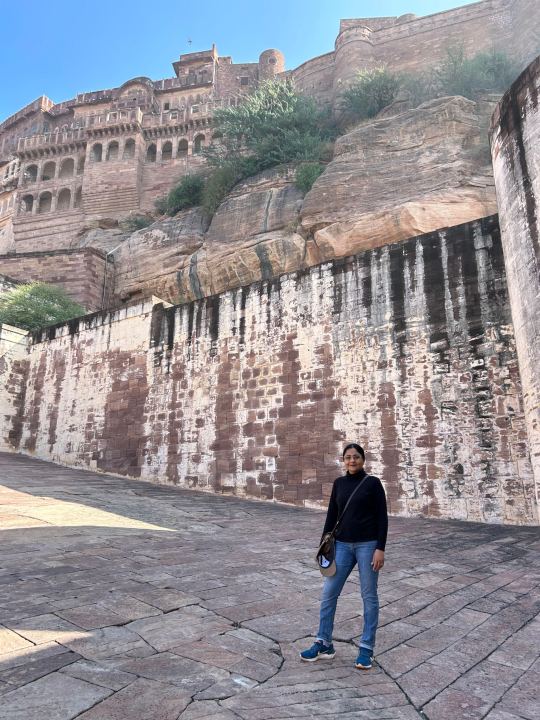
Having lived in Rajasthan for 18 odd years and some 24 years in NCR, I have always wanted to explore the western side of Rajasthan which includes Jodhpur and Jaisalmer. This land of abundant sun, sand and soil was still mysterious to me and evaded me for long until I got an opportunity to go on a road trip this winter of 2023.
Gliding through the glazing smooth butter roads starting from Mumbai expressway in Gurgaon to Jodhpur in Rajasthan, the drive was very smooth except some parts near Ajmer where some re – laying of roads was being carried on but that failed to dampen my enthusiasm in any way.
We touched down Jodhpur by 3 pm and checked into Rani Mahal, an erstwhile haveli run by a mother daughter duo. This 450 years old haveli purchased by Sri Vinod Sa Bhandari against her wife’s wishes was turned into a hotel in 2014. Little did she know that it would become her lifeline and lifelong companion in the time to come when her husband passed away in corona in 2020. From fighting all odds, facing all challenges to supporting her very young kids and putting up a bold facade and protecting her grieving and vulnerable self, she rose to the occasion and took the reins of the hotel in her hands. Smt Nisha Bhandari along with her daughter Ms Mitali Bhandari,is right here at the hotel in the morning to attend to her patrons, asking for feedback, supervising the property and gradually learning the tricks of hospitality industry day by day. Located against the majestic Mehrangarh fort in Nauchowkia, Fatehpur road, Rani Mahal provides a very unique and authentic experience to the guests of living in the city and of the vibrant markets around.

The interiors of Rani Mahal are quite impressive. It houses 19 rooms, all of which are done differently and gives you the feel of what life the maharajas and maharanis of the bygone days must have lived .Breakfast at the terrace against the Mehrangarh fort in the winter chill and sunshine is a different experience altogether . Dinner again at the terrace with live folk music playing adds a dash of charm to your excitement .Lunch is served in the cosy ambience of the ground floor .
One can visit Toorji ka Jhalra, a stepwell constructed in 1740 which is very near to Rani Mahal. One will be surprised to see a very modern market that has come up there in the midst of the old city, near clock tower for the tourists; catering to all your couturial needs and handicrafts for your homes.
A 5 mins walk from Rani Mahal will lead you the major tourist attraction of Jodhpur, yes, you got it right! It’s the Majestic Mehrangarh Fort. Indulge in some adventurous activities before indulging in its historic grandeur .The zip lining at 6 levels is a major draw for the adventurous lot. You get an amazing experience of zipping through lakes, above the fort and enjoy some good aerial views of the fort and the city.
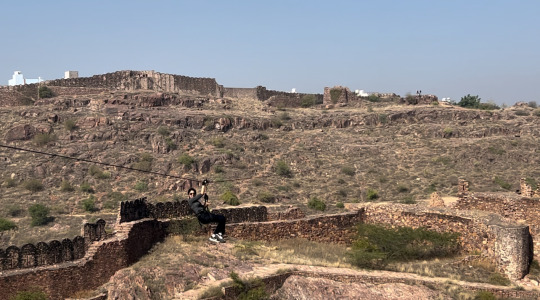
Zip-Lining at Mehrangarh Fort (Agency- Flying Fox)
Once inside the fort, you travel back to old times and remain awestruck looking at the weaponry, the relics, the vibrant costumes and turbans ,the massive palaquins, the huge howdahs used by the members of the royal family. The grandeur and architectural beauty of the fort including the sheesh mahal, Phool mahal have to be seen to be believed.

The restaurant in the fort offers you some really good Rajasthani cuisine like dal- bati churma, traditional thali besides other cuisines . I can vouch that all over Rajasthan ,you will always find good food . The spices used are qualitatively very good but again you will have to savour it to believe it.
Village safari is another tourist attraction that you can pack in your itinerary. The jeep picks you up from the designated point and the driver cum guide takes you to the Bishnoi village enlightening and immersing you with the different aspects of their culture . Not many know that the Bishnoi community of 15 000/ people have a place in history as we read about the ‘chipko movement’. Some 439 bishnois had laid down their lives to prevent the felling of Khejari trees which are sacred to them .Not many know again that it’s the same community that was behind Salman khan’s imprisonment for the infamous black buck hunting case .They believe that their guru Jambkeshwar has been reborn as Black buck, hence the respect for the creature is something that they will never compromise with. Bishnoi, as they got the name from Hindi words for 20 and 9. They believe in 29 principles, hence the name of the community. The foremost principle of their culture is that they don’t burn the dead bodies but bury them as they believe that a lot of wood is burned and wasted in the process. They worship trees, nature and wildlife. Secondly, they hold women in high esteem. The female mukhiya has a distinct appearance from the rest of the ladies in the family like she wears a red skirt, a red turban, a nath and a heavy anklet .

The male mukhiya wears a white turban. He prepares very diligently a drink made of opium which is used to relax their bodies and also on occasions like wedding. They do not take any kind of medicines ,whatsoever ,but rely only on opium for any aches or illnesses but they understand that moderate consumption is the key.
As you navigate further into the open village, you can see black bucks, nilgais, peacocks chinkaras and foxes openly roaming and grazing without fear . You also get to see the live workshop by durry weavers.A durry can take 140 hours of weaving by 2 people on the loom. Cotton and camel wool are used for durry making. The former can fetch double the amount while the latter is cheaper and non- dyeable too.
Block printing live workshops are very interesting to witness. It’s amazing to see vegetable colors and natural dyes being used to transform some plain drab cloth into a vibrant and valuable printed cloth. It’s notable that different castes like chipa, Patels, Bishnois are identified by the different clothes they wear . It’s like understanding that clothes are their I – cards.
As we move to our another district Jaisalmer on roads paved to perfection, I see vast stretches of barren land sans any high rises , my eyes unaccustomed to see. As far as you can see, there are herds of cattle, sheep, cows, goats claiming their land ; turbaned men on charpoys leisurely pulling out the day with no haste ; carefree kids playing some local games and women carrying haystacks on their heads to be used as fodder for the cattle or fuel for cooking.
Enroute Jaisalmer, one can see dates farms and vendors selling so many different varieties of dates that we may not even have heard the names before.
There are certain interesting things you can do like jeep safari, dune bashing, camel riding and parasailing on the Thar desert against the backdrop of the rising sun or against the sun set. Both of these times offer exclusive experiences to cherish.

As I bid adieu to the desert , my heart longs to come back once again and re witness its charm and glory ; savour it’s traditional food ; immerse in the folk music and dance and imbibe the simplicity of this land of sand.
Rani Mahal Contact; Instagram Page – Rani Mahal, Jodhpur
Share this:
Press This
Twitter
Facebook
Customize buttons
Loading…
Leave a Reply
Blog at WordPress.com.
#nature#jodhpur#rajasthan#jaisalmer#vacation#travelling#holiday#rani mahal#hotels#food#culture#holiday season#christmas time#new years
2 notes
·
View notes
Text
Seven-year-old girl sold for Rs 3 lakh to recover father’s debt in Gujarat's Sabarkantha | Rajkot News
PALANPUR: A shocking case of child trafficking came to light in Sabarkantha district, where a seven-year-old girl was allegedly sold to a person in Rajasthan for Rs 3 lakh by three loan sharks to recover the money lent to her father.The incident was reported on Dec 19, 2024, at Himmatnagar City A Division police station. The police registered a case against Arjun Nat and Sharifa Nat from Modasa…

View On WordPress
#child trafficking#child trafficking in India#debt recovery through trafficking#father&x27;s debt#girl sold for Rs 3 lakh#loan sharks#Rajasthan child trafficking case#Rajkot latest news#Rajkot news#Rajkot news live#Rajkot news today#Sabarkantha district news#seven-year-old girl#seven-year-old girl sold#Today news Rajkot
0 notes
Text
10 साल की लड़की को अगवा कर तीन दिन तक पत्नी के सामने किया रेप, अदालत ने सुनाई अंतिम सांस तक कारावास की सजा
Rajasthan News: राजस्थान के अजमेर कुछ महीने पहले एक मामला हुआ था. जिसने पति-पत्नी के रिश्ते को शर्मसार कर दिया. इस मामले में पोक्सो कोर्ट ने अपराधी को अपनी आखिरी सांस तक जेल में रहने की सजा दी है और उसकी पत्नी के खिलाफ वारंट जारी किया है. यह मामला कुछ महीने पहले का है. जिसमें अपराधी दंपति ने एक 10 वर्षीय नाबालिग का उसके घर के पास से किडनैप किया था और फिर उसे गुजरात ले गए. इस मामले में सबसे…
#12 year old rape news#12 year old raped in ujjain#9news#abc news#Ajmer news#Ani news#bangalore rape news#bbc news#bengaluru rape case news#bengaluru rape news#Big news#bs news#CG News#doctor raped in kolkata#dw news#girl raped in puducherry#ht news#hw news#kolkata rape murder news#minor raped in puducherry#minor raped in ujjain#mp news#News#news 12#rajasthan news#rape#Rape News#rape news bangalore#rape news bengaluru#rape sky news
0 notes
Text

Golden Triangle Tour With Jodhpur
Explore the rich cultural diversity of India by expanding The Golden Triangle to include the fascinating city of Jodhpur, the "Blue City," complements this triangle marvelously. Start by touring ancient locations such as the Red Fort and Qutub Minar in Delhi. See the recognizable Taj Mahal and Agra Fort by traveling to Agra. The "Pink City," Jaipur, charms with its Amer Fort and Hawa Mahal. Set against the backdrop of the Thar Desert, Jodhpur enthralls with its magnificent Mehrangarh Fort and lively bazaar. Experience the vibrant bazaars and opulent palaces of Rajasthan, making your trip to Jodhpur and the Golden Triangle a unique Indian experience.
Book your Golden Triangle trip with Vardhman Vacations today and experience the magic of India!
Contact Us:
Email: [email protected]
Phone: +91 98111 75768
#new year holiday#golden triangle package#golden triangle holidays#dooars forest region#delhi agra jaipur tour#dooars forest area#golden triangle tour#wildlife sanctuary#buddhism#heritage hotels#rajasthan palaces#mehrangarh fort jodhpur#jodhpur#tour and travel
0 notes
Text
#best golden triangle tour package#golden triangle tour#Golden Triangle Tour from Delhi#Luxury Golden Triangle Tour Packages#Golden Triangle Budget Tours#Delhi Agra Jaipur Tour Package#Delhi Jaipur Agra Tour#best tour agency in India#india tour operator#Golden Triangle Budget Tour#rajasthan trip#rajasthan tour#new year 2024#new year celebration#chirstmas#india tour packages#rajasthan tour packages
0 notes
Note
can you please educate me on what the waqf board is? Asked my dad and did not understand a thing
According to this website, and many more:
What is a Waqf Board?
A Waqf Board is a legal entity responsible for managing waqf properties and ensuring their use for intended religious, pious, or charitable purposes. The term “waqf” originates from the Arabic word meaning “confinement” or “prohibition.” The board administers and oversees the proper maintenance and use of waqf assets, which include mosques, graveyards, orphanages, schools, and other institutions serving the community.
Now, what else does this board do?
Recently it claimed the land of 103 farmers. It is the third largest land owner in India, the first and second being the Railways and the Defence department. It claimed an entire village in Telangana, as well as one in Bihar. They say they're taking back the lands Muslims once donated, but that's what they say.
The Waqf Act was first passed by Parliament in 1954. Subsequently, it was repealed and a new Waqf Act was passed in 1995 which gave more powers to Waqf Boards. In 2013, this Act was further amended to give unlimited powers to Waqf boards to snatch anyone’s property, which even could not be challenged in any court of law.
Simply put, the Waqf Board has unlimited powers to claim properties in the name of Muslim charity — a power that no other religious body in India enjoys.
Instances of misuse.
• In the Avinashi case, as per revenue records, 216 people from Devendrakula Vellalar community were given free patta for over 6.3 acres of land in Devendran Nagar in Cheyvur in 1996. But the beneficiaries are now worried about the ownership of the land as the Waqf Board, in a letter to sub-registrar offices in Avinashi, Thottipalayam, and Joint I and Joint II sub-registrar offices of Tiruppur district on August 8, claimed around 93 properties on certain survey numbers in Avinashi and Tiruppur as Waqf properties.
• Thiruchenthurai, a village located on the Cauvery river’s bank in Tiruchirapalli district, also has a 1,500-year-old Sundareswarar Temple. Villagers are now wondering how the Waqf will claim ownership of this property as well.
• The Supreme Court recently held that in the absence of any proof of dedication or user, a dilapidated wall or a platform cannot be conferred a status of a religious place for the purpose of offering prayers or Namaaz. The decision came as a big relief for the Telangana government, as the state had subsequently leased out the land for setting up a university, township and other institutions of repute. The state government had appealed to the Supreme Court after losing out before the Andhra Pradesh high court in April 2012.
• The Rajasthan Board of Muslim Waqf has been requesting financial assistance from the Rajasthan government in order to pay its workers’ salaries. This is in strange contrast to the fact that Waqf Board has more than 18,000 properties listed across Rajasthan and it generates income from more than 7,000 properties.
• The Tamil Nadu Waqf Board has claimed ownership of the 1500-year-old Manendiyavalli Chandrashekhara Swami temple land. The temple has 369 acres of property in and around Tiruchenthurai village in Tamil Nadu.
• In 2021, Waqf Board wrote an application to Gujarat High Court, staking claim on the ownership of two islands in Bet Dwarka in Devbhoomi Dwarka. An irate court, however, refused to hear the application.
So uh, it's a bunch of people trying to instigate communal violence. The Hindus better look after this thing imo. This is why the waqf amendment bill is necessary. This board need not have so much power in its hands, and as India claims to be a secular state, no religious body should be having so :)
13 notes
·
View notes
Text
Indian Elections (Part 2)
Part 2 of the result and campaign opinions is here!
I know I said that Rajasthan was Congress's biggest comeback, well I take it back because INDIA alliance won in Maharashtra with Congress getting 13 seats, Shiv Sena (og one) with 9 and NCP (again, og one) with 8. With BJP getting 9 seats, Shiv Sena (Eknath Shinde one) and NCP (new one) getting 7 and 1 seats respectively, NDA lost 28 of its seats. And honestly, what a banger. Sharad Pawar probably deserves credit for this, that man is a shrewd politician. Also, the Congressi responsible for campaigning in Maharashtra also deserves credit, because Congress performed well and beyond the expectations here.
Tamil Nadu my beloved. Major INDIA sweep! DMK (22) and Congress (9) while BJP remained on the zero mark. As expected of the Tamil public. Everyone say thank you to DMK's campaign and BJP's incompetency to get the Tamilians on their side.
Chhattisgarh is an almost BJP sweep, with BJP getting 10 and Congress getting 1. Expected for Congress, given the Vidhaan Sabha results last year.
Another almost BJP (25) sweep is Gujarat, again, as expected. It is, after all BJP's garh, as my mother calls it. Very heavy campaign that paid off for BJP. Hats off to the Congressi who won 1 seat, probably worked very hard on his own.
Things get tricky in Karnataka, where BJP won with 17 seats and Congress got 9. Again, not much familiar with Karnataka politics, but BJP did lose 8 of its seats, so I guess a part of the public is losing trust in the government but it's not a majority yet. A Rajasthan like situation.
TDP shines in Andhra Pradesh with 16 seats, BJP with 4. Congress remained on its zero mark. Chandrababu Naidu come to the INDIA bloc you can be deputy PM
Congress (14), Muslim League (2) and CPIM (1) lead INDIA alliance to an almost sweep in Kerala, BJP getting 1 seat. I'm so glad that Shashi Tharoor won from Thiruvananthapuram, he is a delight to watch.
Things are perfectly balanced as all things should be in Telangana, with both Congress and BJP winning 8 seats each. I guess the public has major divide on issues and opinions.
That's it for this part, I thought this will be done in 2 parts, but guess not.
10 notes
·
View notes
Text

Travel Destination: India
The Death of Vishnu by Manil Suri
Vishnu, the odd-job man, lies dying on the staircase of an apartment building while around him unfold the lives of its inhabitants: warring housewives, lovesick teenagers, a grieving widower. In a fevered state, Vishnu looks back on his love affair with the seductive Padmini and wonders if he might actually be the god Vishnu, guardian of the entire universe.
The Bandit Queens by Parini Shroff
Five years ago, Geeta good for nothing husband walked out leaving her, however the local villiage believe she killed him.
This untrue rumour has some perks, no one messes with her, harasses her or tries to control her (aka marry her), it’s even great for business nobody dares not to buy her jewellery.
However it does have it downside because other women are asking for advice on “losing” their husbands as well and some aren’t asking nicely.
The Marvelous Mirza Girls by Sheba Karim
 To cure her post–senior year slump, made worse by the loss of her aunt Sonia, Noreen is ready to follow her mom on a gap year trip to New Delhi, hoping India can lessen her grief and bring her voice back.
The Henna Artist by Alka Joshi
Lakshmi Shastri has spent years carving out a life for herself as a henna artist after fleeing her abusive husband and backward rural village for the Rajasthan capital.
Well-versed in apothecary and the miraculous properties of herbs, her services are highly sought after by upper-caste women, and Lakshmi’s success brings her within inches from her goal: total independence. That is, until the past she has so desperately tried to run from comes knocking at her door...
The Widows of Malabar Hill by Sujata Massey
Perveen Mistry, the daughter of a respected Zoroastrian family, has just joined her father's law firm, becoming one of the first female lawyers in India. Armed with a legal education from Oxford.
While handlings the will of a wealthy mill owner, Perveen comes across something strange all three widows have sighed away their inheritance to charity, how will they survive with nothing Are they being taken advantage of by an unscrupulous guardian? Perveen tries to investigate and realizes her instincts about the will were correct when tensions escalate to murder. It's her responsibility to figure out what really happened on Malabar Hill, and to ensure that nobody is in further danger.
#world reading challenge#booklr#bookblr#book rec#india#the death of vishnu#manil suri#the bandit queens#parini shroff#the marvelous mitza girls#sheba karim#the henna artist#alka joshi#the widows of malabar hill#sujata massey#ya romance#literary fiction#contemporary#historical#mystey
3 notes
·
View notes
Text
The Sarasvati River (IAST: Sárasvatī-nadī́) is a mythologized and deified ancient river first mentioned in the Rigveda[1] and later in Vedic and post-Vedic texts. It played an important role in the Vedic religion, appearing in all but the fourth book of the Rigveda.
As a physical river in the oldest texts of the Rigveda, it is described as a "great and holy river in north-western India,"[2] but in the middle and late Rigvedic books, it is described as a small river ending in "a terminal lake (samudra)."[3][b] As the goddess Sarasvati, the other referent for the term "Sarasvati" which developed into an independent identity in post-Vedic times.[4] The river is also described as a powerful river and mighty flood.[5] The Sarasvati is also considered by Hindus to exist in a metaphysical form, in which it formed a confluence with the sacred rivers Ganges and Yamuna, at the Triveni Sangam.[6]
Rigvedic and later Vedic texts have been used to propose identification with present-day rivers, or ancient riverbeds. The Nadistuti hymn in the Rigveda (10.75) mentions the Sarasvati between the Yamuna in the east and the Sutlej in the west, while RV 7.95.1-2, describes the Sarasvati as flowing to the samudra, a word now usually translated as 'ocean',[c] but which could also mean "lake."[3][8][9][10][d] Later Vedic texts such as the Tandya Brahmana and the Jaiminiya Brahmana, as well as the Mahabharata, mention that the Sarasvati dried up in a desert.
Since the late 19th century, numerous scholars have proposed to identify the Sarasvati with the Ghaggar-Hakra River system, which flows through modern-day northwestern-India and eastern-Pakistan, between the Yamuna and the Sutlej, and ends in the Thar desert. Recent geophysical research shows that the supposed downstream Ghaggar-Hakra paleochannel is actually a paleochannel of the Sutlej, which flowed into the Nara river, a delta channel of the Indus River. Around 10,000-8,000 years ago, this channel was abandoned when the Sutlej diverted its course, leaving the Ghaggar-Hakra as a system of monsoon-fed rivers which did not reach the sea.[11][12][13][14]
The Indus Valley Civilisation prospered when the monsoons that fed the rivers diminished around 5,000 years ago.[11][13][14][e] and ISRO has observed that major Indus Valley civilization sites at Kalibangan (Rajasthan), Banawali and Rakhigarhi (Haryana), Dholavira and Lothal (Gujarat) lay along this course.[15][web 1] When the monsoons that fed the rivers further diminished, the Hakra dried-up some 4,000 years ago, becoming an intermittent river, and the urban Harappan civilisation declined, becoming localized in smaller agricultural communities.[11][f][13][12][14]
Identification of a mighty physical Rigvedic Sarasvati with the Ghaggar-Hakra system is therefore problematic, since the Gagghar-Hakra had dried up well before the time of the composition of the Rigveda.[16][17][f][13][12][14] In the words of Wilke and Moebus, the Sarasvati had been reduced to a "small, sorry trickle in the desert" by the time that the Vedic people migrated into north-west India.[18] Rigvedic references to a physical river also indicate that the Sarasvati "had already lost its main source of water supply and must have ended in a terminal lake (samudra) approximately 3000 years ago,"[3][b] "depicting the present-day situation, with the Sarasvat�� having lost most of its water."[19][b][20] Also, Rigvedic descriptions of the Sarasvati do not fit the actual course of the Gagghar-Hakra.[21][22]
The identification with the Ghaggar-Hakra system took on new significance in the early 21st century,[24] with some Hindutva proponents suggesting an earlier dating of the Rigveda; renaming the Indus Valley Civilisation as the "Sarasvati culture", the "Sarasvati Civilization", the "Indus-Sarasvati Civilization" or the "Sindhu-Sarasvati Civilization,"[25][26][27] suggesting that the Indus Valley and Vedic cultures can be equated;[28] and rejecting the Indo-Aryan migrations theory, which postulates an extended period of migrations of Indo-European speaking people into the Indian subcontinent between ca. 1900 BCE and 1400 BCE.[h][i]
hey whats up with this. the rigvedas having a lost river and the indian subcontinent having a lost river is so tempting but the timelines dont match up? i guess rivers just dry up (or change course) a lot so it could be any dried up river?
10 notes
·
View notes
Text
New Policies of Rajasthan Government Unveiled: Col Rajyavardhan Rathore
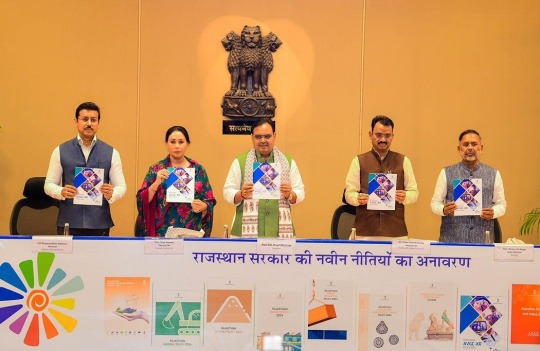
Rajasthan, known for its cultural heritage and historic prominence, is making waves with forward-thinking policies designed to usher in a new era of growth and development. Col Rajyavardhan Rathore, a dynamic leader and advocate of progress, has been instrumental in shaping and supporting these initiatives. These policies aim to address critical areas such as economic development, environmental sustainability, social equity, and digital transformation, marking a significant step forward for the state.
A Vision for Progress
The new policies reflect the Rajasthan government’s commitment to fostering innovation, inclusivity, and sustainability. By targeting various sectors, from education and infrastructure to technology and rural development, these initiatives promise a brighter and more prosperous future for all.
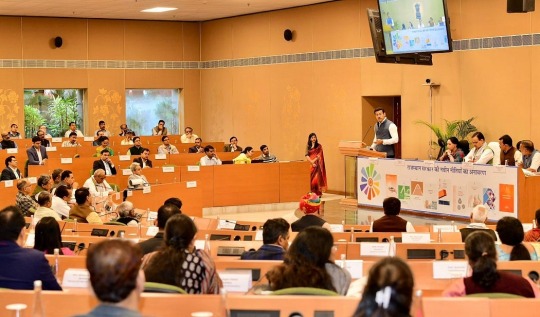
Key Policies Unveiled
1. Rajasthan MSME Policy 2024
Micro, Small, and Medium Enterprises (MSMEs) form the backbone of Rajasthan’s economy. This policy aims to:
Provide financial assistance and subsidies to MSMEs.
Simplify regulatory processes to encourage entrepreneurship.
Create employment opportunities, especially in rural areas.

2. One District, One Product (ODOP) Scheme
To boost local businesses and crafts, the ODOP scheme promotes:
Identifying unique products in each district for focused development.
Establishing market linkages and export support.
Providing branding and marketing assistance to artisans and producers.
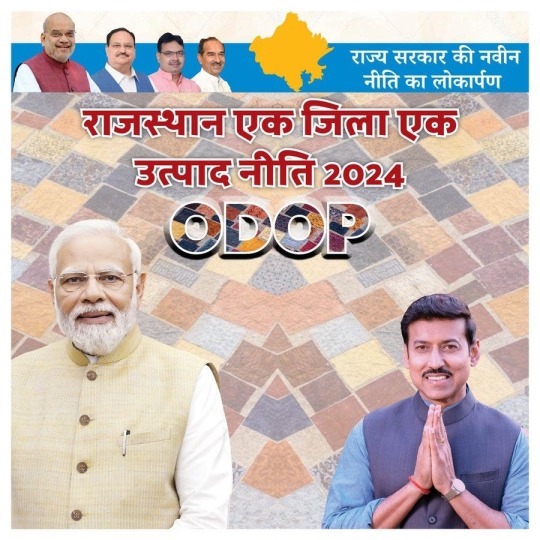
3. Rajasthan Startup Policy 2024
The state’s focus on fostering innovation is evident through its startup-friendly policies, which include:
Seed funding and incubation support for startups.
Incentives for women-led and rural-based startups.
Establishing innovation hubs across districts.

4. Integrated Cluster Development Scheme
This policy aims to modernize and empower traditional industries by:
Developing common facilities for industrial clusters.
Providing training programs for workers in emerging technologies.
Enhancing infrastructure to attract investments.
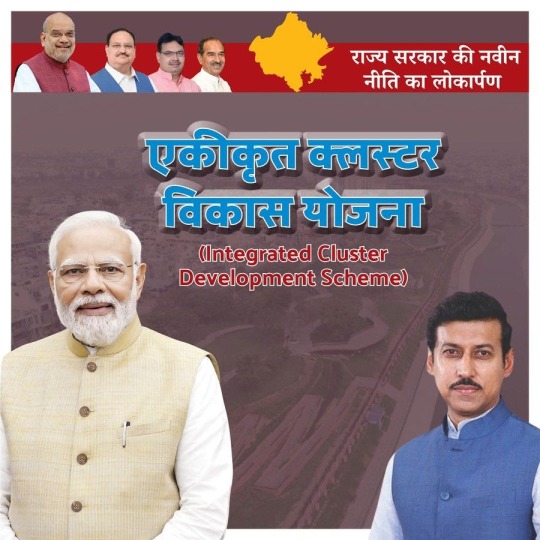
5. Rajasthan AVGC-XR Policy 2024
Focusing on the Animation, Visual Effects, Gaming, and Extended Reality (AVGC-XR) sectors, this policy includes:
Setting up AVGC-XR training institutes.
Providing subsidies for software and hardware procurement.
Promoting Rajasthan as a hub for creative industries.
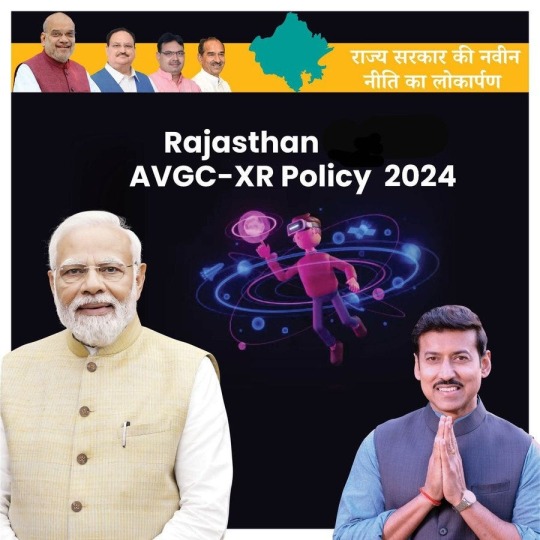
Environmental Sustainability Policies
6. Rajasthan Green Energy Initiative
To combat climate change and boost renewable energy production, the policy emphasizes:
Developing large-scale solar and wind energy projects.
Offering incentives for businesses to adopt green energy solutions.
Encouraging electric vehicle adoption through subsidies.
7. Water Conservation Policy
Addressing water scarcity in Rajasthan, this policy includes:
Promoting rainwater harvesting and groundwater recharge.
Modernizing irrigation systems to improve efficiency.
Encouraging community-driven water conservation efforts.
Social Development Policies
8. Rajasthan Women Empowerment Scheme
Aimed at promoting gender equality, this policy focuses on:
Providing skill training and entrepreneurship opportunities for women.
Ensuring safety and security through improved law enforcement.
Offering financial incentives for girls’ education.
9. Antyodaya Seva Camp Initiative
Launched to mark the successful completion of the BJP government’s first year, this program:
Provides direct access to government schemes and services.
Ensures welfare benefits reach the most marginalized communities.
Organizes awareness drives about social and economic rights.
Education and Digital Transformation
10. Rajasthan DigiSkill Program
To prepare the workforce for a digital future, this program includes:
Training in digital tools, AI, and coding for youth.
Setting up digital labs in schools and colleges.
Offering certifications in high-demand IT skills.
11. Rajasthan Education Excellence Policy
Focused on improving education quality across the state, the policy entails:
Modernizing school infrastructure and integrating digital tools.
Recruiting highly qualified teachers for rural and underserved areas.
Enhancing vocational training opportunities.
Economic Growth and Investment Policies
12. Rising Rajasthan Global Investment Summit
This annual event highlights the government’s commitment to attracting global investments by:
Showcasing Rajasthan’s potential in IT, manufacturing, and tourism.
Facilitating investor-friendly policies and incentives.
Establishing Special Economic Zones (SEZs) for key industries.
13. Rajasthan Export Promotion Policy
Aimed at boosting exports, this policy provides:
Support for exporters through subsidies and infrastructure.
Promotion of Rajasthan’s traditional handicrafts and textiles globally.
Setting up export training centers for budding entrepreneurs.
Col Rajyavardhan Rathore: A Champion of Progress
Col Rajyavardhan Rathore has been a driving force behind these transformative policies. His efforts include:
Advocating for inclusive and sustainable growth.
Encouraging public-private partnerships to enhance infrastructure and investment.
Ensuring that government initiatives are accessible and impactful at the grassroots level.
Impact of the New Policies
Economic Growth
Increased investments in key sectors like IT, renewable energy, and manufacturing.
Growth in MSMEs and startups, creating job opportunities.
Social Development
Enhanced opportunities for women and marginalized communities.
Improved access to education and healthcare.
Sustainability
Progress in renewable energy adoption and water conservation.
Reduced carbon footprint through green energy initiatives.
The Road Ahead
With these policies, Rajasthan is poised to become a leading state in innovation, sustainability, and social equity. The government’s commitment, supported by leaders like Col Rajyavardhan Rathore, ensures that this vision translates into reality. As the state charts its path forward, it sets a benchmark for holistic and inclusive development in India.
2 notes
·
View notes
Text
Rajasthan’s Journey to a 30 Lakh Crore Economy: A Vision for the Future

At the Rising Rajasthan Global Investment Summit 2024, Industry Minister Rajyavardhan Singh Rathore made a bold declaration about the state’s economic future. He highlighted the growth trajectory of Rajasthan’s economy, asserting that while the previous Congress government left behind a state economy worth ₹15 lakh crore, the current vision for the state will see it crossing the ₹30 lakh crore mark in just the next four years. This ambitious plan represents not only a doubling of the state’s economic size but also the transformation of Rajasthan into a major economic powerhouse in India.
This statement, made in the context of the Rising Rajasthan Summit, isn’t just a number. It reflects the aspirations of a state poised to redefine its place in India’s growth story. The summit, a significant platform for global investment, is seen as the starting point for this economic revolution. Let’s explore the key elements that are driving this vision for Rajasthan’s economic future.
From ₹15 Lakh Crore to ₹30 Lakh Crore: The Road Ahead
Rajyavardhan Singh Rathore, in his address at the summit, set the tone for Rajasthan’s ambitious growth plans. He stated that the previous Congress government left the state’s economy at ₹15 lakh crore, but the state is now targeting a bold and transformative leap to ₹30 lakh crore within the next four years. This growth is expected to come from a combination of factors, including a more business-friendly environment, focus on innovation, infrastructure development, and expanding the state’s industrial base.
The core of this vision is the recognition that Rajasthan is no longer just a state dependent on agriculture and mining. Over the past few years, it has rapidly diversified into other sectors, and the current government’s focus on boosting manufacturing, renewable energy, tourism, and technology is set to accelerate this growth.
Key Drivers of Rajasthan’s Economic Growth
1. Industrialization and Infrastructure Development
One of the primary drivers of Rajasthan’s economic growth is its increasing industrial output. The state has emerged as a major player in sectors like manufacturing, textiles, and electronics. With the government’s focus on improving infrastructure — especially transport, logistics, and industrial corridors — Rajasthan is becoming a hub for industries looking to tap into India’s growing demand for goods and services.
The development of the Delhi-Mumbai Industrial Corridor (DMIC) and other projects such as the Rajasthan Investment Promotion Scheme (RIPS) are opening up new opportunities for large-scale industrial growth. Rajasthan’s favorable policies and initiatives, including subsidies, tax breaks, and incentives for businesses, are attracting both domestic and foreign investments. These measures are expected to make the state a manufacturing powerhouse and increase its contribution to India’s overall GDP.
2. Renewable Energy Leadership
Rajasthan is already a leader in renewable energy, particularly in solar energy. The state boasts some of the best solar energy resources in India, making it a key player in the country’s transition to renewable energy. The government has set ambitious goals to expand solar energy capacity, with plans to increase renewable energy output significantly over the next few years.
By harnessing the power of the sun, Rajasthan aims to become a global leader in renewable energy, not just for domestic consumption but for export as well. This growth in renewable energy will not only generate power but also create jobs, drive investment, and make Rajasthan a key player in the global green energy revolution.
3. Tourism as a Growth Catalyst
Rajasthan is one of India’s most visited states, with its royal history, palaces, forts, and natural beauty attracting millions of tourists every year. The government has recognized the immense potential in expanding the tourism sector, especially eco-tourism, adventure tourism, and cultural tourism.
The Rising Rajasthan Summit also highlighted the opportunities in creating world-class infrastructure for tourists, developing new tourist circuits, and leveraging digital platforms for promoting tourism. By enhancing tourism infrastructure, Rajasthan can generate significant economic activity, create employment, and contribute to the overall growth of the state’s economy.
4. Skilled Workforce and Education
A critical component of Rajasthan’s economic future is its focus on skill development. The government is committed to improving education, providing job-specific training, and building a workforce that is capable of meeting the demands of a rapidly changing economy.
With an emphasis on sectors like information technology, engineering, healthcare, and tourism, the state is creating the necessary human capital to drive its ambitious growth targets. Skill development centers, vocational training institutes, and a focus on entrepreneurship are expected to empower the youth of Rajasthan to become contributors to the state’s economic growth.
The Role of the Rising Rajasthan Summit
The Rising Rajasthan Global Investment Summit 2024 was not just an event, but a significant milestone in the state’s journey towards achieving its economic goals. The summit served as a platform to showcase the state’s potential to global investors and business leaders, while also highlighting the government’s commitment to building an ecosystem that supports growth and innovation.
The summit emphasized the state’s readiness to embrace new technologies, foster innovation, and ensure that Rajasthan remains at the forefront of India’s industrial and economic transformation. From attracting foreign direct investment (FDI) to promoting local entrepreneurs, the summit is expected to catalyze the economic growth needed to reach the ₹30 lakh crore target.
Challenges and Opportunities
While Rajasthan’s growth prospects are incredibly promising, the journey to a ₹30 lakh crore economy will not be without its challenges. Issues such as improving infrastructure, ensuring sustainable growth, bridging the urban-rural divide, and promoting inclusive development need to be addressed. However, the government is aware of these challenges and is actively working towards overcoming them.
The vision of a ₹30 lakh crore economy by 2028 is ambitious, but with the right policies, leadership, and collaborations, it is achievable. The state’s vast resources, industrial potential, and commitment to innovation make it an exciting place to invest and do business.
Rajyavardhan Singh Rathore’s statement at the Rising Rajasthan Global Investment Summit 2024 marks the beginning of a bold new chapter for Rajasthan. With an economy poised to more than double in just four years, the state is entering a period of rapid transformation. The summit is a clear signal that Rajasthan is not only rising but is ready to become a key player in India’s economic future.
As the state continues to diversify its economy, attract global investments, and innovate across sectors, Rajasthan is setting itself on a trajectory of sustainable, inclusive, and dynamic growth. The next few years will define the state’s future, and if the ambitious vision laid out by the government is realized, Rajasthan will become one of the most powerful economic engines in India.
4 notes
·
View notes
Text

https://www.reuters.com/business/aerospace-defense/boeing-imposes-hiring-freeze-takes-steps-conserve-cash-after-strike-starts-2024-09-16/
2 notes
·
View notes
Text
15 साल की लड़की की गांव के लड़के से करवाई शादी, अब हुई दो महीने की गर्भवती; अब दर्ज करवाया रेप का केस
Rajasthan News: सीकर जिले के ग्रामीण इलाके में एक 15 साल की नाबालिग ने पति पर रेप का केस कराया है. पीड़िता ने बताया कि शादी के बाद पति ने रेप किया. वह अभी 2 महीने की गर्भवती है. पुलिस ने पीड़िता की तहरीर पर पॉक्सो एक्ट सहित अन्य धाराओं में मुकदमा दर्ज कर लिया. पुलिस पूरे मामले की जांच में जुटी है. 2 महीने की प्रेग्नेंट है किशोरी पीड़िता में नेछवा थाने में रिपोर्ट दर्ज कराया. किशोरी ने बताया कि…
0 notes
Text
My Journey to Olympic Silver — Colonel Rajyavardhan Rathore
Introduction: A Triumph of Dedication and Perseverance

Early Life and Beginnings: Foundations of a Champion
Colonel Rajyavardhan Rathore was born on January 30, 1970, in Jaisalmer, Rajasthan, India. Growing up in a family with a strong military background, he was imbued with a sense of discipline and commitment from an early age. Rathore’s initial interest in sports was evident during his school years, where he participated in various athletic events. However, it was his introduction to shooting that would ultimately define his path to Olympic glory.
The Turning Point: Embracing the Sport of Shooting
Rathore’s transition from general sports to competitive shooting was a pivotal moment in his career. His journey began with modest beginnings, practicing diligently at local ranges and honing his skills. His decision to focus on shooting was influenced by a combination of personal passion and the guidance of experienced mentors. Rathore’s dedication to mastering the sport was evident in his rigorous training schedules and relentless pursuit of perfection.
Training Regimen: The Rigorous Path to Excellence
Achieving Olympic success in shooting requires more than just talent; it demands a meticulous training regimen. Colonel Rathore’s preparation was characterized by intense physical conditioning, mental fortitude, and technical precision. His daily routine involved:
Physical Conditioning: Rathore engaged in a comprehensive fitness program to enhance his stamina, strength, and overall physical health. This included cardiovascular exercises, strength training, and flexibility routines.
Mental Training: The mental aspect of shooting is crucial. Rathore practiced meditation and visualization techniques to improve focus and composure during competitions. This mental training helped him maintain a calm demeanor under pressure.
Technical Practice: Hours of practice at shooting ranges were essential to perfecting his technique. Rathore worked on refining his shooting posture, breath control, and accuracy. Regular participation in national and international competitions also played a significant role in his development.

The Road to Athens: Preparation and Challenges
As the 2004 Athens Olympics approached, Colonel Rathore’s preparation intensified. The journey to the Olympics was fraught with challenges, including:
Injury and Recovery: Rathore faced several injuries during his training. Each setback required careful rehabilitation and adjustments to his training regime, demonstrating his resilience and commitment.
Competition Pressure: The pressure of competing on an international stage is immense. Rathore’s ability to handle this pressure was a testament to his mental strength and preparation.
Olympic Success: The Silver Medal Achievement

Post-Olympic Era: Legacy and Impact
Following his Olympic success, Colonel Rathore continued to inspire and contribute to the field of sports. His post-Olympic endeavors included:
Advocacy for Sports Development: Rathore has been an advocate for the development of sports infrastructure and support systems in India. His efforts have contributed to the growth of shooting sports and the encouragement of young athletes.
Mentorship and Coaching: As a mentor and coach, Rathore has played a significant role in nurturing new talent. His insights and experience have been invaluable in guiding the next generation of shooters.
Lessons from Colonel Rathore’s Journey
Colonel Rajyavardhan Rathore’s journey to Olympic silver offers several valuable lessons:
Commitment to Excellence: Rathore’s success underscores the importance of dedication and commitment. His rigorous training and perseverance highlight the need for unwavering focus in achieving one’s goals.
Resilience in Adversity: Overcoming injuries and competition pressure demonstrates the importance of resilience. Rathore’s ability to bounce back from setbacks serves as a powerful reminder of the strength needed to achieve success.
Continuous Improvement: Rathore’s journey is a testament to the value of continuous improvement. His relentless pursuit of perfection in shooting exemplifies the need for constant self-assessment and enhancement.

Conclusion: A Beacon of Inspiration

3 notes
·
View notes